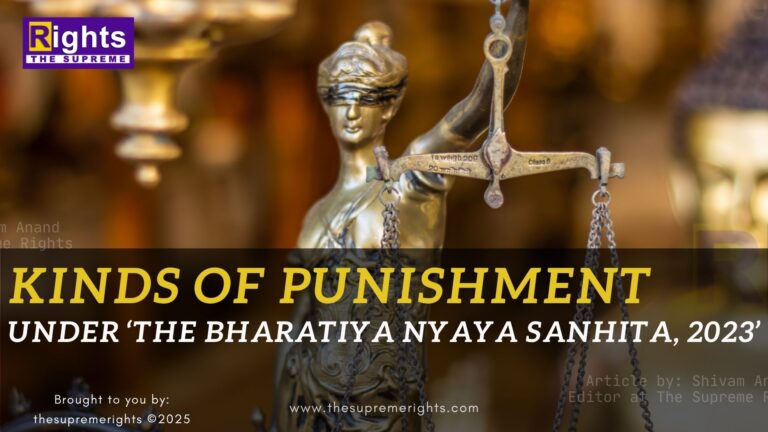The Indian Penal Code (IPC), as its name suggests, primarily aimed to punish wrongdoers. In contrast, the Bharatiya Nyaya Sanhita (BNS), as stated during its introduction in Parliament, is centered around the idea of ‘Nyaya’ — Justice. While many call BNS “old wine in a new bottle,” it does bring certain upgrades, especially when it comes to types of punishments. One such notable addition is Community Service.
This article is a simplified breakdown of the various forms of punishment under the BNS, 2023.
Kinds of Punishments under the Bharatiya Nyaya Sanhita, 2023
Under the IPC, 1860, there were five types of punishments. The BNS, however, has expanded this list to six:
- Death Penalty (Capital Punishment)
- Life Imprisonment
- Imprisonment for a specified term
- Forfeiture of property
- Fine
- Community Service (newly introduced)
These are codified under Section 4 of the BNS.
1. Death Penalty
Also called Capital Punishment, this involves sentencing a person to death for committing an extremely serious offence. It is essentially State-sanctioned execution, applied in rarest of rare cases such as terrorism, dacoity with murder, and brutal homicide.
Despite ongoing debates and opposition from human rights groups, the Government of India retained the death penalty while replacing the IPC with the BNS. However, it is important to note that death sentences are rarely executed in India even if pronounced.
2. Life Imprisonment
Second only to the death penalty in severity, life imprisonment is often misunderstood as imprisonment till natural death. Under Section 6 of the BNS, unless specifically stated otherwise, life imprisonment is equated to 20 years.
In some exceptional cases, courts may direct imprisonment till the end of natural life, especially when the death penalty is commuted to life imprisonment.
3. Imprisonment for a Specific Term
This is the most commonly awarded punishment. A person is sentenced to jail for a specific term, within the minimum and maximum limits prescribed for that offence.
For instance, Section 95 of BNS (involving hiring or engaging a child to commit a crime) prescribes imprisonment not less than three years, and up to ten years.
Two sub-types of such imprisonment exist:
- Rigorous Imprisonment – Includes hard labor like mining, carpentry, or construction.
- Simple Imprisonment – Involves confinement without hard labor.
The nature of imprisonment (rigorous or simple) is left to the discretion of the court.
4. Forfeiture of Property
This refers to confiscation or loss of property as a penalty for a specific offence. Typically, this includes any property used during the commission of the crime.
For example, under Section 154, any person involved in committing depredation in territories of a foreign State at peace with India shall face forfeiture of the property used in such acts.
5. Fine
Fines are the most frequently used punishment. They may be imposed alone or in combination with imprisonment.
In some offences, the exact fine amount is mentioned in the law. In others, it is left to the discretion of the judge. Courts also specify a default imprisonment term in case the convict fails to pay the fine.
6. Community Service (New Addition)
This is a progressive addition to BNS, introduced for the first time in Indian statutory criminal law. Although not defined in detail, the court may order the convict in petty issues to perform useful community work like:
- Planting trees
- Cleaning public places or parks
- Assisting in libraries or schools, etc.
Earlier, some Indian courts had experimented with such punishments. The BNS now formally includes it as a recognized penal consequence, empowering courts to impose it wherever deemed appropriate.
Conclusion
While much of the Bharatiya Nyaya Sanhita retains the older framework of the IPC, the introduction of community service reflects a shift towards reformative justice. Understanding the kinds of punishments under BNS helps us appreciate the evolving approach of Indian criminal law — one that balances deterrence, reformation, and justice.

